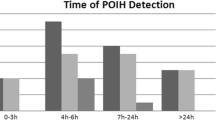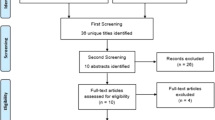Abstract
Purpose
Routine immediate postoperative brain CT (RIPO CT) has advantages and disadvantages. The present study was performed to know the extent of gain by RIPO CT in the aspect of immediate postoperative patient care in pediatric patient population and according to the disease entity and surgical procedure.
Methods
We reviewed 910 cases of pediatric brain surgery performed from January 2008 to March 2010 who had RIPO CT. The value of each examination was graded according to the impact of the CT findings on the decision making processes on postoperative patient care or on the understanding of postoperative patient’s status: level I (urgent surgical procedures are necessary), level II (high level of attention should be paid because of possible urgent surgical procedure in near future), level III (RIPO CT is useful for understanding of postoperative change of patient’s status), and level IV (no significant gain). The number of patients in each level was evaluated, and proportions of levels according to disease entity and surgical procedure were compared.
Results
In total, the proportion of each level of I to IV was 0.4%, 4.9%, 3.5%, and 91.2%, respectively. The group of brain tumors, especially those who have malignant or highly vascular tumors, showed significantly higher value of RIPO CT. Cases of traumatic epidural hematoma and intracerebral hemorrhage revealed significantly high proportion of level II although no case underwent reoperation.
Conclusions
The results of present study may be useful for making policy of “selective” application of immediate postoperative brain CT according to the patient conditions. Also the use of immediate postoperative brain CT can be decided in individual cases by considering disease entity and surgical procedure.


Similar content being viewed by others
References
Barnes NP, Jones SJ, Hayward RD, Harkness WJ, Thompson D (2002) Ventriculoperitoneal shunt block: what are the best predictive clinical indicators? Arch Dis Child 87(3):198–201
Beckmann U, Gillies DM, Berenholtz SM, Wu AW, Pronovost P (2004) Incidents relating to the intra-hospital transfer of critically ill patients. An analysis of the reports submitted to the Australian Incident Monitoring Study in Intensive Care. Intensive Care Med 30(8):1579–1585
Brenner DJ, Hall EJ (2007) Computed tomography—an increasing source of radiation exposure. N Engl J Med 357(22):2277–2284
Brenner D, Elliston C, Hall E, Berdon W (2001) Estimated risks of radiation-induced fatal cancer from pediatric CT. AJR Am J Roentgenol 176(2):289–296
Fanara B, Manzon C, Barbot O, Desmettre T, Capellier G (2010) Recommendations for the intra-hospital transport of critically ill patients. Crit Care 14(3):R87
Khaldi A, Prabhu VC, Anderson DE, Origitano TC (2010) The clinical significance and optimal timing of postoperative computed tomography following cranial surgery. J Neurosurg 113(5):1021–1025
Lin JP, Pay N, Naidich TP, Kricheff II, Wiggli U (1977) Computed tomography in the postoperative care of neurosurgical patients. Neuroradiology 12(4):185–189
Pudenz RH, Foltz EL (1991) Hydrocephalus: overdrainage by ventricular shunts. A review and recommendations. Surg Neurol 35(3):200–12
Rumboldt Z, Huda W, All JW (2009) Review of portable CT with assessment of a dedicated head CT scanner. AJNR Am J Neuroradiol 30(9):1630–1636
Smits M, Dippel DW, Nederkoorn PJ, Dekker HM, Vos PE, Kool DR, van Rijssel DA, Hofman PA, Twijnstra A, Tanghe HL, Hunink MG (2010) Minor head injury: CT-based strategies for management—a cost-effectiveness analysis. Radiology 254(2):532–540
Studdert DM, Mello MM, Gawande AA, Gandhi TK, Kachalia A, Yoon C, Puopolo AL, Brennan TA (2006) Claims, errors, and compensation payments in medical malpractice litigation. N Engl J Med 354(19):2024–2033
Watkins L, Hayward R, Andar U, Harkness W (1994) The diagnosis of blocked cerebrospinal fluid shunts: a prospective study of referral to a paediatric neurosurgical unit. Childs Nerv Syst 10(2):87–90
Waydhas C (1999) Intrahospital transport of critically ill patients. Crit Care 3(5):R83–89
Author information
Authors and Affiliations
Corresponding author
Rights and permissions
About this article
Cite this article
Jung, Jm., Lee, J.Y., Phi, J.H. et al. Value of routine immediate postoperative brain computerized tomography in pediatric neurosurgical patients. Childs Nerv Syst 28, 673–679 (2012). https://doi.org/10.1007/s00381-012-1716-x
Received:
Accepted:
Published:
Issue Date:
DOI: https://doi.org/10.1007/s00381-012-1716-x




